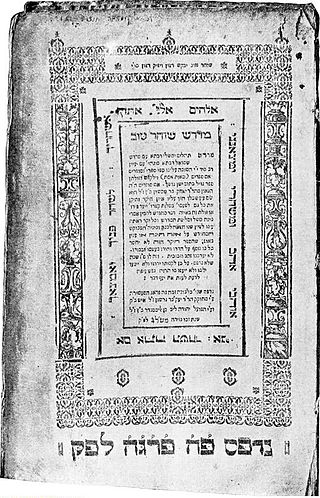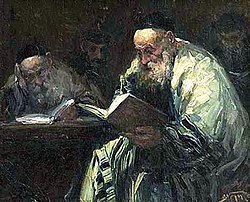
Midrash is expansive Jewish Biblical exegesis using a rabbinic mode of interpretation prominent in the Talmud. The word itself means "textual interpretation", "study", or "exegesis", derived from the root verb darash (דָּרַשׁ), which means "resort to, seek, seek with care, enquire, require", forms of which appear frequently in the Hebrew Bible.
The Ketuvim is the third and final section of the Tanakh, after Torah ("instruction") and Nevi'im ("prophets"). In English translations of the Hebrew Bible, this section is usually titled "Writings" or "Hagiographa".

Genesis Rabbah is a religious text from Judaism's classical period, probably written between 300 and 500 AD with some later additions. It is a midrash comprising a collection of ancient rabbinical homiletical interpretations of the Book of Genesis.

The Five Scrolls or the Five Megillot are parts of the Ketuvim ("Writings"), the third major section of the Tanakh. The Five Scrolls are the Song of Songs, the Book of Ruth, the Book of Lamentations, Ecclesiastes and the Book of Esther. These five relatively short biblical books are grouped together in Jewish tradition.

The Biblia Hebraica Stuttgartensia, abbreviated as BHS or rarely BH4, is an edition of the Masoretic Text of the Hebrew Bible as preserved in the Leningrad Codex, and supplemented by masoretic and text-critical notes. It is the fourth edition in the Biblia Hebraica series started by Rudolf Kittel and is published by the Deutsche Bibelgesellschaft (German Bible Society) in Stuttgart.
Tobiah ben Eliezer was a Talmudist and poet of the 11th century, author of Lekach Tov or Pesikta Zutarta, a midrashic commentary on the Pentateuch and the Five Megillot.

Midrash Tanhuma, also known as Yelammedenu, is the name given to a homiletic midrash on the entire Torah, and it is known in several different versions or collections. Tanhuma bar Abba is not the author of the text but instead is a figure to whom traditions are frequently attributed to, though he may have preserved a collection of midrashim used by other midrash editors. The name Yelammedenu derives from the Hebrew phrase yelammedenu rabbenu, which initiates a typical textual unit in the text.

Numbers Rabbah is a religious text holy to classical Judaism. It is a midrash comprising a collection of ancient rabbinical homiletic interpretations of the book of Numbers.
Enoch Zundel ben Joseph was a Polish Talmudist best known as author of three commentaries on Ein Yaakov, He authored the books "Etz Yosef", "Anaf Yosef", and "Yad Yosef". He also wrote commentaries on Midrash Rabbah, Midrash Tanchuma and others. He spent his life in Białystok, Poland; he was a maggid there and gave shiurim on Midrash.

Midrash Abkir is one of the smaller midrashim, the extant remains of which consist of more than 50 excerpts contained in the Yalkut Shimoni and a number of citations in other works. It dealt, according to all accessible evidence, only with the first two books of the Pentateuch.

Midrash Proverbs is the aggadic midrash to the Book of Proverbs.

The Yalkut Shimoni, or simply Yalkut, is an aggadic compilation on the books of the Hebrew Bible. It is a compilation of older interpretations and explanations of Biblical passages, arranged according to the sequence of those portions of the Bible to which they referred.

The Midrash on Lamentations is a midrashic commentary to the Book of Lamentations.

Ecclesiastes Rabbah or Kohelet Rabbah is an aggadic commentary on Ecclesiastes, included in the collection of the Midrash Rabbot. It follows the biblical book verse by verse, only a few verses remaining without commentary.

Deuteronomy Rabbah is an aggadah or homiletic commentary on the Book of Deuteronomy.

Ruth Rabbah is an haggadic and homiletic interpretation of the Book of Ruth. Like the midrash on the four other "megillot", it is included in the Midrash Rabbot.

Midrash Aseret ha-Dibrot or Midrash of the Ten Statements is one of the smaller midrashim which dates from about the 10th century, and which is devoted entirely to the Shavuot holiday; a Vatican library manuscript in fact calls it "an aggadah for Shavuot."

Midrash Samuel is an aggadic midrash on the books of Samuel.
Joseph ben Simeon Kara, also known as Mahari Kara, was a French Bible exegete who was born and lived in Troyes.

Shir haShirim Zutta is a midrash on Shir haShirim.





